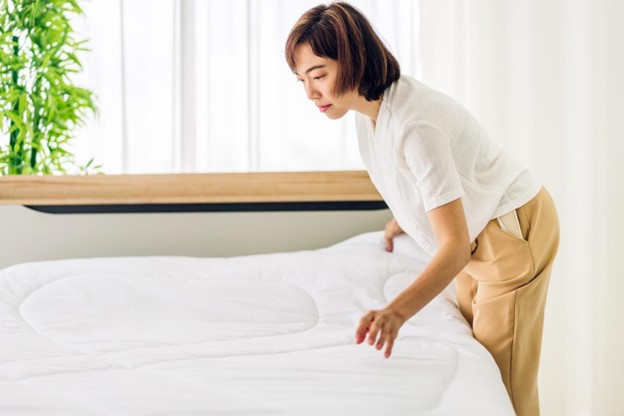If you’ve been sleeping on the same mattress for more than 10 years, it may be time to start shopping for a new one. Most mattresses have a 7- to 10-year timeframe, but there are additional factors to consider if you’ve been wondering about the state of your mattress.
According to research, sleeping on a mattress of medium firmness or one that offers adjustable firmness, supports optimal spinal alignment, bodily comfort, and sleep quality. Most people who sleep on medium-firm mattresses, including foam mattresses with medium firmness, report falling asleep faster and experiencing less discomfort. Comparisons between firm (hard) mattresses, water beds, and foam mattresses also showed that water beds and foam mattresses help minimize back pain better than firm mattresses.

Additional studies that compared soft, medium firm, firm, or custom-inflated mattresses indicate that high-quality mattresses (e.g., adjustable, custom-inflated) are linked to fewer reports of lower back pain than standard-quality mattresses, and medium-firm mattresses are associated with being more comfortable than soft mattresses. Furthermore, a mattress that is too firm prevents the shoulders from relaxing and may contribute to neck or upper back pain. There is also a general consensus that foam mattresses provide more comfort than traditional spring coil mattresses, with research suggesting that foam mattresses can help lower the risk of back pain by:
- Supporting the natural curve of the spine
- Responding appropriately to pressure points
- Evenly distributing bodyweight
- Reducing fatigue and stress on the body
On the other hand, people who are prone to conditions that cause night sweats or hot flashes may prefer spring coil mattresses, as they allow increased airflow that offers a cooler surface while sleeping. The final decision depends on personal preference and the level of comfort an individual experiences when sleeping on a specific type of mattress. In general, if you regularly wake up feeling relaxed and refreshed, your mattress may be providing the right amount of comfort and support.
If your mattress has visible indentations or makes excessive noise (e.g., squeaking, creaking) when you move around on your bed, this could indicate a problem. As mattress support decreases, you may also wake up with chronic back pain or stiffness that lessens during the day. Research shows that people who sleep on uncomfortable mattresses have a higher risk of sleep-related issues, such as body aches and poor sleep quality.
When visible changes are observed or persistent discomfort develops, first consider flipping your mattress over, especially if your mattress is less than 7 years old. Your mattress can be rotated about once or twice a year to help maintain support, with the exception of pillow top mattresses. If the opposite side of your mattress is still uncomfortable and disrupts your sleep, it needs to be replaced. Research consistently shows that a new bedding system, including pillows that provide proper head and neck support, can dramatically improve sleep quality and health. This means that replacing an old mattress in a timely manner can have a positive impact on your overall quality of life.
If you’re dealing with chronic discomfort due to suspected mattress problems, our physiotherapists at Impact Physio & Sport Clinic can assess your sleeping posture and help make recommendations for bedding systems that help reduce pain and sleep disturbances. An individualized physiotherapy plan also helps address spinal alignment issues linked to an uncomfortable mattress. It’s important to remember that a better mattress leads to a better life.
References
- Radwan A, Fess P, James D, et al. Effect of different mattress designs on promoting sleep quality, pain reduction, and spinal alignment in adults with or without back pain; systematic review of controlled trials. Sleep Health. 2015;1(4):257-267.
- BergholdtK, Fabricius R, Bendix T. Better backs by better beds? Spine. 2008;33(7):703-708.
- Jacobson B, Wallace T, Smith D, Kolb T. Grouped comparisons of sleep quality for new and personal bedding systems. Appl Ergon. 2008;39(2):247-254.
- Jacobson B, Boolani A, Smith D. Changes in back pain, sleep quality, and perceived stress after introduction of new bedding systems. J Chiropr Med. 2009;8(1):1-8.
- Roslim R, Mok KL, Fatimah Rubaizah MR, et al. Novel deproteinised natural rubber latex slow-recovery foam for health care and therapeutic foam product applications. JRR. 2018;21:277-292.
- Ancuelle V, Zamudio R, Mendiola A, et al. Effects of an adapted mattress in musculoskeletal pain and sleep quality in institutionalized elders. Sleep Science. 2015;8(3):115-120.
